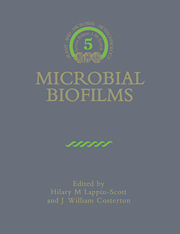Book contents
- Frontmatter
- Contents
- List of Contributors
- Series Preface
- Introduction to Microbial Biofilms
- Part I Structure, Physiology and Ecology of Biofilms
- 1 Growth of Microorganisms on Surfaces
- 2 Dynamics of Bacterial Biofilm Formation
- 3 Cultivation and Study of Biofilm Communities
- 4 Genetic Responses of Bacteria at Surfaces
- 5 Biochemical Reactions and the Establishment of Gradients within Biofilms
- 6 Mechanisms of the Protection of Bacterial Biofilms from Antimicrobial Agents
- Part II Biofilms and Inert Surfaces
- Part III Biofilms on the Surfaces of Living Cells
- Index
3 - Cultivation and Study of Biofilm Communities
Published online by Cambridge University Press: 24 November 2009
- Frontmatter
- Contents
- List of Contributors
- Series Preface
- Introduction to Microbial Biofilms
- Part I Structure, Physiology and Ecology of Biofilms
- 1 Growth of Microorganisms on Surfaces
- 2 Dynamics of Bacterial Biofilm Formation
- 3 Cultivation and Study of Biofilm Communities
- 4 Genetic Responses of Bacteria at Surfaces
- 5 Biochemical Reactions and the Establishment of Gradients within Biofilms
- 6 Mechanisms of the Protection of Bacterial Biofilms from Antimicrobial Agents
- Part II Biofilms and Inert Surfaces
- Part III Biofilms on the Surfaces of Living Cells
- Index
Summary
The need for laboratory studies of biofilm communities
If microbial ecology is to move forward, it must go beyond the reduction of the complexities of bacteria into merely isolated cell lines, enzymes, and genetic sequences. A century of pure culture studies has provided extremely detailed information on the biochemistry, physiology and genetics of bacteria. What remains to be determined is how they function as successful members of interacting communities in biofilms and how microbial communities function as components of the environment.
Filling this gap in knowledge involves more than the in situ enumeration of cells, molecules, and genetic sequences. It requires that microbial communities be considered as functional units of ecological activity. Individual microorganisms are often tightly coupled with other community members through a complex network of interactions. The genetic programming of each species may be considered to be a reproductive strategy formulated over 2.5 billion years of natural selection, and intricately intertwined with the survival of other organisms (Margulis 1981). Consequently, the most rigorous measure of understanding must involve not only the cultivation of isolated cell lines, but also the successful cultivation and characterization of dynamic microbial communities, complete with their predators and parasites.
End of the pure culture era
The primary axiom of bacteriology is that organisms must be isolated prior to their identification and study, and prior to the description of new species (Koch 1881, 1884). This axiom is so pervasive that it impacts protozoology, mycology and algology as well as bacteriology.
- Type
- Chapter
- Information
- Microbial Biofilms , pp. 64 - 79Publisher: Cambridge University PressPrint publication year: 1995
- 12
- Cited by

